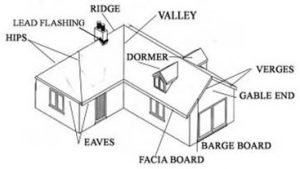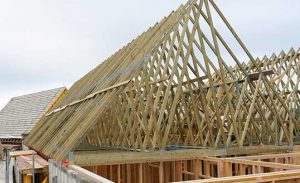Pitched Roof: Parts, 6 Types & Benefits of Pitched Roof
Pitched roofs are the most common types of roof and with an angle of usually, over 20 degrees pitched roof comprising a sloping surface or surfaces.
With a ridge at its highest point, It is a bi-fold, bi-planer roof and a pitched roof requires a pitch of more than 10 degrees or a roof with two slopes that meet at a central ridge to be more specific.

To ensure maximum protection they remain the most common and efficient solution in wet and cold weather and gives the more classical appearance.
Parts of Pitched Roof:
There are following major parts of the pitched roof as given below;
- Eaves and Gable.
- Flashing and Hip.
- Ridge & Purlins.
- Fascia and Rafter.
- Battens and Joist.

Eaves and Gable:
The lower portion of the inclined roof which is projecting beyond the outer face of the wall in the roof is called eaves and the main function of eaves is to rainwater to flow on the exterior wall from the roof directly. Eaves also give protection from the sunlight.
At the end of a ridge roof, the triangular upper part of the wall is called gable.
Flashing and Hip:
To prevent moisture from entering the wall and roof through joints in parapet wall, copings, and other penetrations through the roof plane, flashings are provided.
Between two intersecting roof slopes, the outer angle formed by the inclined ridge that is more than 180 degrees is known as hip.
Ridge & Purlins:
At the apex of the two rising roof surfaces, the horizontal intersection inclined in opposite directions is called a ridge.
From wood or steel purlins are made and to support common rafter of a roof when the span is large these are laid on principal rafters on wall-to-wall.
Fascia and Rafter:
At eaves, fascia is a wooden board fixed to the feet of the common rafter and the ends of the lower-most roof covering material.
Rafter is a pitched roof structural component and it starts from roof support like column or wall to hip or ridge. To support the purlin, multiple rafters are used side by side with equal spacing. Wooden rafters are used in typical home construction while steel rafters are used for large industrial or commercial sheds.
Battens:
To support the roofing materials such as tiles, sheets, etc battens are thin strips of wood that are fixed on the common rafters or on the top of ceiling boards.
Types of Pitched Roof:
There are the following types of pitched roof such as;
- Mono Pitch Roof.
- Couple Roof.
- Closed Couple Roof.
- Collar Roof.
- Purlin Roof.
- Trussed Rafter.
Mono Pitch Roof:
To form extensions, slopes from one side, this type is commonly used and at the top of a wall, a series of rafters are fixed to plates. To a wall plate, the rafter feet are nailed and across the supporting wall, it distributes the load evenly.

To form level ceilings joists are fitted and to give more height these could be raised. By struts, joists are commonly supported which stop rafters from sagging.
Couple Roof:
This type comprises two lengths of rafters leaning against each other and tied where they meet at the top and it is the simplest form of the pitched roof.
Closed Couple Roof:
In this type of making the structure much more secure, ceiling joists are added and a length of timber running horizontally in-between the rafter feet and joist prevents the outward deflection of the wall and to approximately 5 m, increases the potential roof-span.

In this type, much of the roof space could be utilized for storage and allowed the space to be used by using struts.
Collar Roof:
In the roof space, the height of the ceiling joists are raised and the roof allowed for any upper rooms to be constructed in this type of roof.
The disadvantage of this method is that lifting the ceiling joist reduces its restraining force and increasing the instability of the supporting walls.

The height of the ceiling joist could be lifted to a maximum of 1/3 of the height of the roof for maintaining stability.
Purlin Roof:
Without compromising wall stability, increasing the size of rafters or attracting extra costs, purlins roof spans could be increased and Purlins allow rafters to get extra support and become lighter and thinner.

The advantage of this roof is that much of the roof space could be utilized for storage and ultimately allowed the space to be used by using struts.
Trussed Rafter:
In modern house construction, the fink or ‘w’ truss is the most common form of the trussed rafter and consists of a rafter comprising W shaped tension and to accommodate many different pitch angles this trussed rafter is capable of spans up to 12 m.

The advantage of the trussed rafter is that the off-site assembly of the trussed rafter which speeds up the whole construction process but where a change of direction occurs in the roof it requires careful design.
Benefits of Pitched Roof:
There are the following benefits of the pitched roof as given below;
Style:
In all shapes and sizes, these roofs come and provide a more stylish and beautiful appearance.
Thermal Insulation:
The pitched roofs buildings are roughly 10 to 15% more compact and by simply limiting the size of the surface exposed to the exterior, this reduction results in higher thermal insulation.
Protection against Environmental Hazards:
To withstand snow, ice, water, and wind these roofs are built and they ensure perfect water drainage because of triangle shape and they are stable and stronger.
Cost-Effective Additional Space:
Without the need to add an additional and costly floor to the whole building, these types of roofs allow for extra rooms or storage spaces below them.
Rainwater Reuse:
To reuse rainwater this type of roof makes it easier and to modify and redirect the external drainage system is easier. Some tiles for this kind of roof have no effect on water quality such as natural slate, which is produced without using any chemical products.
We Love Cricket